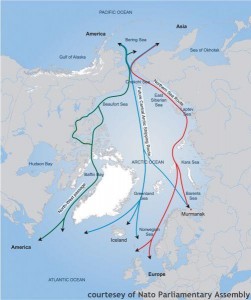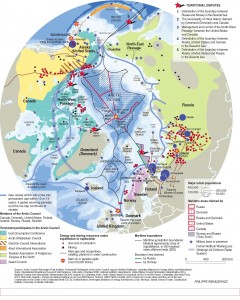[slidepress gallery=’general-jacoby’]
2013-01-02 Arctic warming is creating a new Arctic environment and with it a new strategic situation.
Changes are coming over time, but the strategic trajectories are very clear.
New transportation routes, new resources, new security challenges and new defense dynamics are inevitable.
And very little of this is at the discretion of American choices.
Global dynamics, indeed globalization itself is pushing the Arctic onto the center stage in ways that the US really faces one of two choices: it ignores the Arctic and fails to protect its interests, or it shapes an effective approach and rolls out resources appropriately over time and does so interactively with allies.
The second is the logical choice, but for many Americans – or those who think about it– the Arctic is either an eco preserve or a commercial development site with security and defense concerns distant considerations. But the reality is that managing security in the Arctic is a sine qua non for resource development, safe transportation and environmental protection.
Let us simply look at three examples of why the opening of the Arctic is part of a strategic shaping function.
First, new transportation routes already are opening up and over time, direct routes between the Atlantic and the Pacific will be possible.
And Europe and the Pacific shipping routes will be significantly altered. The Northern Sea Route along the arctic coast of Russia eventually will reduce a maritime journey between East Asia and Western Europe from 21,000 km using the Suez Canal to 12,800 km, cutting transit time by 10-15 days.
For example, the distance from Rotterdam to Yokohama is 20,600 km via the Suez Canal. Via a Northern route the distance is reduced to 8,500 km.
Second, the map changes. Russia in Asia and Russia in Europe become “connected.” The Pacific air and naval fleets can be interconnected creating a force to shape a strategic reality at the top of the world providing for power projection southward.
Another change will be the augmentation of the role of Northern Europe. Northern Europe will become connected with the Pacific in a new way.
If one looks at the map below the bifurcation of the top of the world which is melded over time suggests the geopolitical dynamics and changes.
Third, there are significant resources at stake, oil, gas and rare earth minerals to name a few. The Arctic 5, or Russia, the US, Canada, Norway and Denmark, are the major claimants to the known resources. But others are eagerly involved in staking claims to what is not claimed and pouching on what is.
China has clearly marked the Arctic as a domain of strategic significance and interest, and their land grab for rare earth minerals in Greenland, their building of new icebreakers and their focus on the strategic impact of the new transportation routes for commercial and military purposes are clear manifestations of intent.
Much like the recent Chinese e-passports lay claim to resources in the South China Sea and India, their activities in the Artic both now and in the future are clear indications of intent.
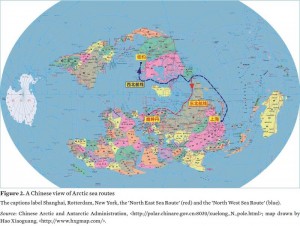
https://sldinfo.com/china-and-the-arctic-an-element-of-an-evolving-global-strategy/
https://sldinfo.com/china-and-its-policies-towards-energy-rich-territories-in-asia-pacific/
In a wide-ranging interview with the dual-hatted commander of NORAD and USNORTHCOM, General Charles Jacoby, Jr., the General focused on the centrality of the Arctic both now and in the future.
At Second Line of Defense, we consider the Arctic to be integrally intertwined with any new Pacific strategy. The dynamics of change associated with the Arctic clearly are re-shaping, both now and in the future, the geographical canvas on which US defense and security policy in the Pacific needs to be sketched.
For now, the Arctic is part of the Pacific but over time, the region is a bridge shaping new geo-political realities in which the Pacific and Atlantic are linked.
Not having an effective strategy now puts one in a catch up position as geopolitical evolution unfolds.
In a wide-ranging discussion with the General, he candidly discussed the situation today and its evolution in the future. A key theme for the General is the clear need to build capabilities and presence over time, but to do so with clear engagement of US allies and with clear-headed thinking about how to evolve capabilities to keep pace with the growth in challenges.
One needs a step-by-step approach, but one has to define some of the end states of needed presence and capability to leverage investments, infrastructure and operational engagements over time.
SLD: How important are security and defense considerations to the future of Arctic development?
Jacoby: They are very significant. For some, the development of the Arctic is about commercial or environmental issues alone. But without security in the Arctic, one cannot have sound commercial or environmental development.
And it is important for us to get out in front on the Arctic, because if we don’t, other nations will define our Arctic future for us.
And if we make smart investments over time in security and defense for the Arctic, we can get ahead of the game.
As I look at the Arctic, I think of it in terms of where there is key terrain that we must be prepared to defend. Just like I look at where our key terrain is in the homeland – Washington, D.C., or the New York Stock Exchange, for example — I need to know where the key terrain is in the Arctic.
The Bering Strait, for instance, has the potential to become another Strait of Malacca. As the ice melts, it will take on significant and global economic importance. There are also locations where mining or energy extraction will take place.
Capability gaps create vulnerabilities.
I have direction in the Unified Command Plan to look carefully at what these might be, and advocate for ways to fill them. Of course, we will not do this alone. Our principal ally in the Arctic is Canada, and we have a shared stake with them in the peaceful development of the Arctic.
But it’s important to remember that the Bering Strait is not the Strait of Hormuz. This is an evolving issue, not a today issue.
We need to make advances over time that allow us to stay ahead of evolving problems, with a solid strategic direction defined and in place.
There is a school of thought that says we can have competitive commercial and economic interests in the Arctic, but not have any associated security challenges.
That’s simply not the way the world works.
Economic opportunities and challenges shape or imply security interests. We need to not only be prepared to take advantage of and exploit the economic opportunities in the Arctic, but also to be prepared to address security challenges.
SLD: The environment is a difficult one. And shaping a proper infrastructure to support Arctic operations both now and in the future is a challenging one. What are your thoughts on how to deal with the infrastructure challenge?
Jacoby: The Arctic is a challenging environment in which to work and for which to plan. A key element is to shape a flexible, agile and responsive approach with our mission partners. Instead of having separate bases and facilitates in the region, we are looking to have a consolidated approach.
We simply cannot afford to have unnecessarily redundant facilities in the Arctic region. The different stakeholders need to work together to share in building these capabilities.
We need an inclusive approach to this challenge, and in this case, an opportunity as well.
Earlier this year, (U.S. Coast Guard Commandant) Admiral Papp and I identified four key capability gaps in the Arctic. Those are: communications, domain awareness, infrastructure and presence.
We need to focus our investments in enhancing capabilities in each of those areas over time.
We are using our exercise programs to explore those capabilities gaps, and look for high-payoff investments that we can make. We are working with our components, especially the Navy and Air Force, to help build to those capabilities. And because we are taking an allied and whole-of-government approach, capabilities can be leveraged not just from the services, but from other agencies, from the commercial sector, or from allies like Canada.
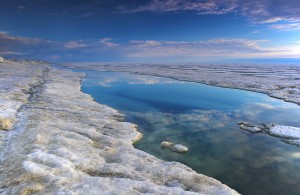
SLD: Do you see a significant uptake in activity by countries like Russia and China in the Arctic?
Jacoby: We do. The Chinese are building icebreakers, which clearly are not for operation in the South China Sea. Russia is the most active. There are concerns about freedom of navigation in the Northern Sea Route.
These developments do not have to be contentious, but it is foolish to think that economic and resource competition won’t lead to occasional disagreements.
And as there starts to be more human activity in the Arctic, for us it will require communications, domain awareness, infrastructure and presence of some sort.
We could wait and be behind the curve in the Arctic. But in a harsh climate like that, when you’re behind, you’re way behind.
By not rolling out capabilities on a steady basis, at any given time we’re not just one season away, we’re three seasons away from having that runway, that hangar, that piece of concrete, or that pier that we might need to support operations.
SLD: Let us return to the question of infrastructure. What is your thinking about offshore and shore based infrastructure requirements for an Arctic presence?
Jacoby: A key element is to shape forward operating bases in Alaska and the Arctic. There are going to be several stakeholders in the area. We need to be willing and looking at ways to share amongst all stakeholders.
Shore-based facilities might need to be complemented with offshore facilitates.
Even in the warm season — in fact, especially in the warm season — hardened ships, whether they’re icebreakers or hardened Arctic-capable ships, are going to be required to do our most basic missions of safety, security and defense. You won’t be able to do it completely from shore-based facilities.
SLD: Obviously, the trajectory is clear, of growing activity, opportunities and challenges in the Arctic. The defense aspect was clear in the Cold War period in terms of submarine development, how will the defense aspect become clearer to folks over time?
Jacoby: Three or four NORAD commanders from now, the Secretary of Defense or the Canadian Minister of Defense is going to ask, who is coming back and forth through the Bering Straits, what are they doing in the Arctic, what are their capabilities, and does that represent a threat?
We can wait and surge capabilities to respond and spend enormous amounts of money in a crisis or we can try to shape the capabilities we need over time to be prepared to answer those questions.
SLD: Canada is a crucial partner in all of this. How would characterize the Canadian role from your perspective? It will be important to leverage one another’s investments and capabilities, I would assume?
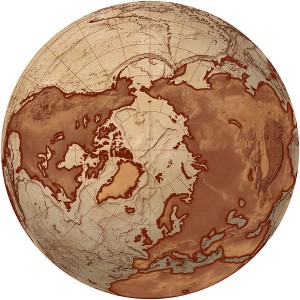
Jacoby: It will be critical to do so. We will need better satellite coverage of the region. But it doesn’t have to be a DoD satellite, or even an American satellite. There are investments that all the stakeholders can make, whether they are the U.S. government, Canada, the State of Alaska, or commercial enterprises. One of the things we’re doing as part of our Arctic campaign plan is we’re forming an Arctic board with the University of Alaska at Fairbanks to bring together all of the stakeholders to talk about this.
With such an approach we can leverage and share resources. For example, we might learn through these discussions that we need a piece of concrete within 200 miles of the North Slope. And if so, who are the different partners who can use that and invest in that so we can share the capability.
And Canada will be represented in that process. There’s a natural affinity between NORTHCOM and the new Canadian Joint Operations Command, and between Joint Task Force Alaska and Canadian Joint Task Force North, and we’re trying to enhance cooperation among those groups.
With my NORAD hat on, I have the ability to help both the U.S. and Canada plan together and say, okay, what do we need in the Arctic in terms of presence, in terms of domain awareness, in terms of communications ability for our joint defense?
Clearly, the Arctic is an emerging opportunity but also an emerging challenge.
It requires vision. We need to see past the near term. If we wait for the first oil gusher, the first cruise ship to run aground, the first environmental catastrophe, or the first security challenge to arise before we start investing in these capability gaps, we will be too late. That’s why we are working with all of the stakeholders today to start meeting this challenge.
The captions for the photos in the slideshow are below:
- In photo 1, Gen. Charles Jacoby, commander of NORAD and USNORTHCOM, gives a keynote address to the Celebrate America’s Military Spirit of America Dinner hosted by the San Antonio Chamber of Commerce Nov. 8. The event featured military attendees from local installations as well as community and civic leaders. (U.S. Army photo by Sgt. Lee Ezzell)
- In photo 2, a formation of Sailors, assigned to Commander, U.S. Third Fleet, render honors to Commander, NORAD and USNORTHCOM, Army Gen. Charles Jacoby, during a visit to Third Fleet headquarters in San Diego. Jacoby met with Commander, U.S. Third Fleet, Vice Adm. Gerald R. Beaman for a routine visit. U.S. Third Fleet leads naval forces in the eastern Pacific from the west coast of North America to the International Date Line. (U.S. Navy Photo by Mass Communications Specialist 2nd Class Torrey W. Lee)
- In photo 3, Secretary of Defense Leon Panetta and Army Gen. Charles H. Jacoby, Jr., NORAD and USNORTHCOM commander, talk during the Inaugural Trilateral Meeting of North American Defense Ministers March 27. (Courtesy Photo)
- In photo 4, Adm. Mariano Saynez, Secretary of the Navy, Mexico, escorted by Army Gen. Charles H. Jacoby, Jr., NORAD and U.S. Northern Command commander, departs the NORAD and USNORTHCOM headquarters with honors after his final visit to the commands Nov. 26, 2012.After speaking at a gathering of NORAD and USNORTHCOM members, honors were rendered in front the headquarters, where Jacoby presented Saynez with an engraved artillery casing and the Mexican flag flown in front of the building. Saynez’s support of USNORTHCOM has been instrumental in the fight against transnational criminal organizations. (U.S. Air Force photo by Tech. Sgt. Thomas J. Doscher)
- In photo 5, Army Gen. Charles Jacoby, Jr., North American Aerospace Defense Command and U.S. Northern Command commander is greeted by the 17 Wing Honour Guard upon his arrival at Canadian Forces Base Winnipeg for a visit to the Canadian NORAD Region headquarters Jan. 24. (Canadian Forces photo by Cpl. Piotr Figiel) CANADIAN FORCES BASE WINNIPEG, Canada
- In photo 6, the Commander of Canada Command, Lieutenant-General Walter Semianiw (left) and the Commander of NORAD and United States Northern Command (USNORTHCOM), General Charles H. Jacoby, Jr. signed military to military plans in Ottawa on 25 January 2012, to enhance defence cooperation between Canada and the United States, should the governments require each other> ‘> s assistance. The documents signed were the Civil Assistance Plan (CAP), the Combined Defence Plan (CDP) and an Information Sharing Memorandum of Understanding (MOU). General Jacoby signed the CAP and the CDP in his capacity as the Commander of USNORTHCOM and the MOU as the Commander of NORAD and USNORTHCOM. The signings followed the 228th meeting of the Permanent Joint Board on Defence (PJBD) in Ottawa.
- In photo 7, Army Gen. Charles H. Jacoby, Jr., NORAD and U.S. Northern Command commander, conducts a tour of MAFFS operations with Air Force Lt. Col. Luke Thompson, 302nd Airlift Wing Chief of Airborne Firefighting, on Peterson Air Force Base, Colo., June 28. Four MAFFS units from the 302nd and 153rd Airlift Wings are currently supporting wildland fire fighting operations in Colorado. PETERSON AIR FORCE BASE, Colo.
For a look at an important US-Canadian agreement on Artic engagement involving NORTHCOM/NORAD see the following:
https://sldinfo.com/u-s-canada-expand-arctic-cooperation-military-training/
The core documents signed between the US and Canada can be downloaded below:
Framework for ARCTIC Cooperation
And for General Jacoby’s presentation at the time of dedicating the new NORTHCOM facility and remembering the anniversary of September 11th see the video below:


